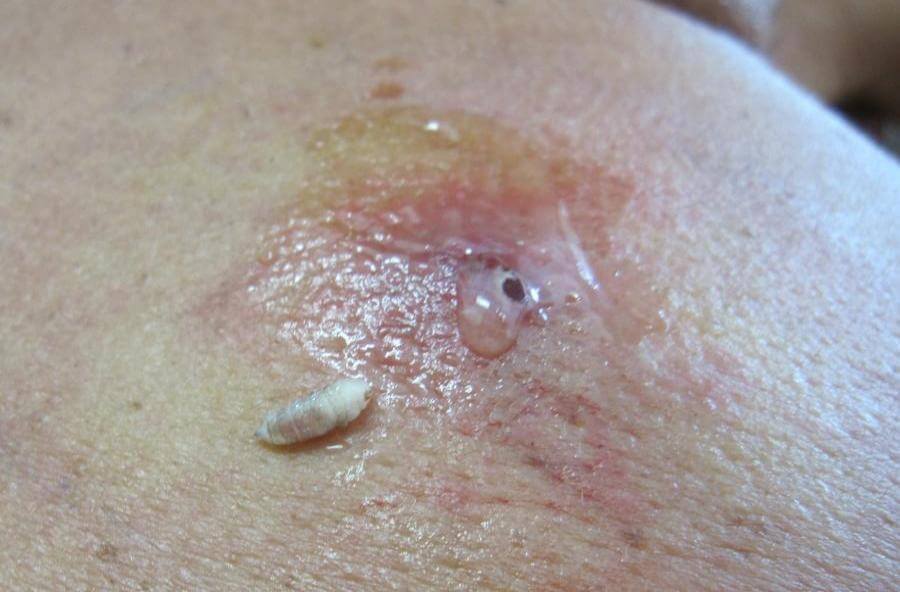Myiasis Causes, Symptoms, Diagnosis and Treatment

What is Myiasis?
Myiasis is defined as the invasion of live vertebrates (humans and/or animals) with dipterous larvae. In mammals (including humans), dipterous larvae can feed on the host’s living or dead tissue, liquid body substance, or ingested food and cause a broad range of infestations depending on the body location and the relationship of the larvae with the host.
Causes of Myiasis
The most common flies that cause the infection in human beings include:
- Dermatobiahominis (human botfly)
- Cordtlobia anthropophagi fly (tumbu fly)
The various methods by which the larvae can enter the human body include:
- Gets attached to the underside of a female mosquito, and penetrates the unbroken skin while the mosquito feeds
- Get attached with the clothing or towel left out in the open to dry and then enter the human skin
- Enter the body through open wounds and lesions, or even through unbroken skin
- Through the nose and ears
- Can reach the stomach and intestine when they are accidently swallowed with food; this leads to Gastric or Intestinal Myiasis
A boil-like lesion then develops rapidly at the infected site, which is red in color and tender to touch. This is accompanied by shooting pains caused by the movement of the organisms inside the wound.
Symptoms of Myiasis
The symptoms of Myiasis differ as per the location of the infection and include the following:
- Cutaneous Myiasis:
- Painful and slow developing ulcers
- Sores and boils that lasts for a prolonged period
- Nasal Myiasis:
- Nose congestion
- Nose blockages
- Nose irritation
- Fever
- Facial edema (swelling of the face)
- Aural Myiasis:
- Crawling sensation in the region
- Buzzing noises
- Hearing disturbances
- Rarely, it may be accompanied by smelly discharge
- Opthalmomyiasis:
- Severe irritation in the eye
- Redness of the eye
- Swelling of the eyes
The general symptoms of Myiasis may include:
Diagnosis of Myiasis
The diagnosis of Myiasis involves the following tests and exams:
- A complete evaluation of medical history and a thorough physical exam
- During the patient’s evaluation, the emphasize may be on:
- Details of any recent visits to the tropical and sub-tropical areas
- Patient’s socioeconomic and hygiene status
The following tests are usually done:
- Blood tests, such as complete blood count, which may show increased white blood cells
- Ultrasound of the affected region to localize the larva and extent of involvement. This can help enable the surgeon to remove the larva without damaging other important parts like the facial nerve
- MRI scan in case of brain, face, and orbit Myiasis
- Biopsy of the wound may be performed: A small sample of the tissue is removed and sent to a lab for examination under the microscope
Treatment of Myiasis
The larvae need to be surgically removed by a medical professional. Typically, the wound is cleaned daily after the larvae are removed. Proper hygiene of wounds is very important when treating myiasis. Sometimes medication is given, depending on the type of larva that causes the problem.
Related Articles:
Candidiasis Causes, Symptoms, Diagnosis and Treatment
Jacquest Erythema Causes, Symptoms, Diagnosis and Treatment
Herpes Zoster Causes, Symptoms, Diagnosis and Treatment
Yaws Causes, Symptoms, Diagnosis and Treatment
Molluscum Contagiosum Causes, Symptoms, Diagnosis and Treatment
Seborrheic Dermatitis Causes, Symptoms, Diagnosis and Treatment
Monkey Pox Causes, Symptoms, Diagnosis and Treatment
Osteomyelitis Causes, Symptoms, Diagnosis and Treatment
Radiation Sickness Causes, Symptoms, Diagnosis and Treatment
Typhus Causes, Symptoms, Diagnosis and Treatment
By : Natural Health News




